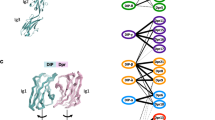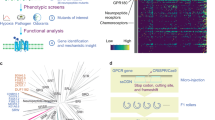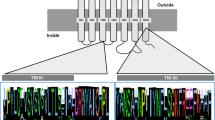Abstract
G protein–coupled receptors (GPCRs) mediate signaling from extracellular ligands to intracellular signal transduction proteins1. Methuselah (Mth) is a class B (secretin-like) GPCR, a family typified by their large, ligand-binding, N-terminal extracellular domains2. Downregulation of mth increases the life span of Drosophila melanogaster3; inhibitors of Mth signaling should therefore enhance longevity. We used mRNA display selection4,5 to identify high-affinity (Kd = 15 to 30 nM) peptide ligands that bind to the N-terminal ectodomain of Mth. The selected peptides are potent antagonists of Mth signaling, and structural studies suggest that they perturb the interface between the Mth ecto- and transmembrane domains. Flies constitutively expressing a Mth antagonist peptide have a robust life span extension, which suggests that the peptides inhibit Mth signaling in vivo. Our work thus provides new life span–extending ligands for a metazoan and a general approach for the design of modulators of this important class of GPCRs.
This is a preview of subscription content, access via your institution
Access options
Subscribe to this journal
Receive 12 print issues and online access
$259.00 per year
only $21.58 per issue
Buy this article
- Purchase on Springer Link
- Instant access to full article PDF
Prices may be subject to local taxes which are calculated during checkout




Similar content being viewed by others
Accession codes
References
Strader, C.D., Fong, T.M., Tota, M.R., Underwood, D. & Dixon, R.A.F. Structure and function of G protein-coupled receptors. Annu. Rev. Biochem. 63, 101–132 (1994).
Harmar, A.J. Family-B G-protein-coupled receptors. Genome Biol. 2 REVIEWS3013 (2001).
Lin, Y.-J., Seroude, L. & Benzer, S. Extended life-span and stress resistance in the Drosophila mutant methuselah. Science 282, 943–946 (1998).
Roberts, R.W. & Szostak, J.W. RNA-peptide fusions for the in vitro selection of peptides and proteins. Proc. Natl. Acad. Sci. USA 94, 12297–12302 (1997).
Takahashi, T.T., Austin, R.J. & Roberts, R.W. mRNA display: ligand discovery, interaction analysis and beyond. Trends Biochem. Sci. 28, 159–165 (2003).
Howard, A.D. et al. Orphan G-protein-coupled receptors and natural ligand discovery. Trends Pharmacol. Sci. 22, 132–140 (2001).
Milligan, G. Strategies to identify ligands for orphan G-protein-coupled receptors. Biochem. Soc. Trans. 30, 789–793 (2002).
Szekeres, P.G. Functional assays for identifying ligands at orphan G protein-coupled receptors. Receptors Channels 8, 297–308 (2002).
West, A.P., Jr., Llamas, L.L., Snow, P.M., Benzer, S. & Bjorkman, P.J. Crystal structure of the ectodomain of Methuselah, a Drosophila G protein-coupled receptor associated with extended lifespan. Proc. Natl. Acad. Sci. USA 98, 3744–3749 (2001).
Grauschopf, U. et al. The N-terminal fragment of human parathyroid hormone receptor 1 constitutes a hormone binding domain and reveals a distinct disulfide pattern. Biochemistry 39, 8878–8887 (2000).
Wilmen, A., Göke, B. & Göke, R. The isolated N-terminal extracellular domain of the glucagon-like peptide-1 (GLP)-1 receptor has intrinsic binding activity. FEBS Lett. 398, 43–47 (1996).
Schatz, P.J. Use of peptide libraries to map the substrate specificity of a peptide-modifying enzyme: a 13 residue consensus peptide specifies biotinylation in Escherichia coli. Biotechnology (NY) 11, 1138–1143 (1993).
Ja, W.W., Olsen, B.N. & Roberts, R.W. Epitope mapping using mRNA display and a unidirectional nested deletion library. Protein Eng. Des. Sel. 18, 309–319 (2005).
Cvejic, S., Zhu, Z., Felice, S.J., Berman, Y. & Huang, X.-Y. The endogenous ligand Stunted of the GPCR Methuselah extends lifespan in Drosophila. Nat. Cell Biol. 6, 540–546 (2004).
Clackson, T. & Wells, J.A. A hot spot of binding energy in a hormone-receptor interface. Science 267, 383–386 (1995).
Phelps, C.B. & Brand, A.H. Ectopic gene expression in Drosophila using GAL4 system. Methods 14, 367–379 (1998).
Baldal, E.A., Baktawar, W., Brakefield, P.M. & Zwaan, B.J. Methuselah life history in a variety of conditions, implications for the use of mutants in longevity research. Exp. Gerontol. 41, 1126–1135 (2006).
Mockett, R.J. & Sohal, R.S. Temperature-dependent trade-offs between longevity and fertility in the Drosophila mutant, methuselah. Exp. Gerontol. 41, 566–573 (2006).
Song, W. et al. Presynaptic regulation of neurotransmission in Drosophila by the G protein-coupled receptor Methuselah. Neuron 36, 105–119 (2002).
Ja, W.W. & Roberts, R.W. G-protein-directed ligand discovery with peptide combinatorial libraries. Trends Biochem. Sci. 30, 318–324 (2005).
Ja, W.W., Wiser, O., Austin, R.J., Jan, L.Y. & Roberts, R.W. Turning G proteins on and off using peptide ligands. ACS Chem. Biol. 1, 570–574 (2006).
Mirzabekov, T., Kontos, H., Farzan, M., Marasco, W. & Sodroski, J. Paramagnetic proteoliposomes containing a pure, native, and oriented seven-transmembrane segment protein, CCR5. Nat. Biotechnol. 18, 649–654 (2000).
Bieri, C., Ernst, O.P., Heyse, S., Hofmann, K.P. & Vogel, H. Micropatterned immobilization of a G protein-coupled receptor and direct detection of G protein activation. Nat. Biotechnol. 17, 1105–1108 (1999).
Stenlund, P., Babcock, G.J., Sodroski, J. & Myszka, D.G. Capture and reconstitution of G protein-coupled receptors on a biosensor surface. Anal. Biochem. 316, 243–250 (2003).
Ja, W.W. & Roberts, R.W. In vitro selection of state-specific peptide modulators of G protein signaling using mRNA display. Biochemistry 43, 9265–9275 (2004).
Kurz, M., Gu, K. & Lohse, P.A. Psoralen photo-crosslinked mRNA-puromycin conjugates: a novel template for the rapid and facile preparation of mRNA-protein fusions. Nucleic Acids Res. 28, e83 (2000).
Myszka, D.G. & Morton, T.A. CLAMP: a biosensor kinetic data analysis program. Trends Biochem. Sci. 23, 149–150 (1998).
Rubin, G.M. & Spradling, A.C. Genetic transformation of Drosophila with transposable element vectors. Science 218, 348–353 (1982).
Lewis, E.B. A new standard food medium. Drosophila Inf. Serv. 34, 117–118 (1960).
Palczewski, K. et al. Crystal structure of rhodopsin: a G protein-coupled receptor. Science 289, 739–745 (2000).
Acknowledgements
We thank A.M. Giannetti for technical expertise on the Biacore; D.G. Myszka (University of Utah) for the SPR analysis software, Scrubber and CLAMP; M.I. Simon for use of the Flexstation automated fluorescence plate reader; T. Brummel and D. Walker for their technical expertise on the life span experiments; T.T. Takahashi and G.B. Carvalho for comments on the manuscript; and S. Cvejic and X.-Y. Huang (Cornell University Weill Medical College) for providing the HEK-Mth cell lines and details on their protocols. We are grateful to P.M. Snow (deceased, 2004) for his expertise in protein purification. This work was supported by grants from the US National Institutes of Health (R01 GM60416 to R.W.R. and R01 AG016630 to S.B.) and the Beckman Foundation (R.W.R.). W.W.J. was supported in part by a US Department of Defense National Defense Science and Engineering Graduate Fellowship, a Scholarship for Research in the Biology of Aging sponsored by the Glenn Foundation for Medical Research and the American Federation for Aging Research, and a John Douglas French Alzheimer's Foundation Postdoctoral Fellowship. A.P.W., Jr. was supported by a Career Award in the Biomedical Sciences from the Burroughs Wellcome Fund.
Author information
Authors and Affiliations
Contributions
W.W.J., A.P.W., Jr. and S.L.D. performed research; all authors designed research and discussed results; W.W.J., A.P.W., Jr., S.B. and R.W.R. wrote the manuscript.
Corresponding author
Ethics declarations
Competing interests
The authors declare no competing financial interests.
Supplementary information
Supplementary Fig. 1
Selected peptides recognize the full-length Methuselah receptor. (PDF 39 kb)
Supplementary Fig. 2
Amino acid analysis of selected peptides. (PDF 71 kb)
Supplementary Fig. 3
Peptide binding site is not localized to Methuselah Trp120. (PDF 56 kb)
Supplementary Fig. 4
Expression of R8-12 extends Drosophila lifespan. (PDF 127 kb)
Supplementary Fig. 5
Binding analysis of R8-04 to Methuselah by surface plasmon resonance. (PDF 62 kb)
Supplementary Table 1
Selected peptide sequences from Methuselah selection. (PDF 28 kb)
Supplementary Table 2
Crystallography data collection and refinement statistics. (PDF 34 kb)
Rights and permissions
About this article
Cite this article
Ja, W., West, A., Delker, S. et al. Extension of Drosophila melanogaster life span with a GPCR peptide inhibitor. Nat Chem Biol 3, 415–419 (2007). https://doi.org/10.1038/nchembio.2007.2
Received:
Accepted:
Published:
Issue Date:
DOI: https://doi.org/10.1038/nchembio.2007.2
This article is cited by
-
G protein-coupled receptors that influence lifespan of human and animal models
Biogerontology (2022)
-
Methuselah/Methuselah-like G protein-coupled receptors constitute an ancient metazoan gene family
Scientific Reports (2016)
-
The repertoire of G protein-coupled receptors in the human parasite Schistosoma mansoni and the model organism Schmidtea mediterranea
BMC Genomics (2011)
-
Genome-wide analysis of low-dose irradiated male Drosophila melanogaster with extended longevity
Biogerontology (2011)
-
Methuselah antagonist extends life span
Nature Chemical Biology (2007)



